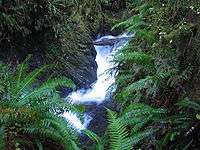Polystichum munitum
| Polystichum munitum | |
|---|---|
_001.jpg) | |
| Western sword fern growing in the Columbia River Gorge | |
| Scientific classification | |
| Kingdom: | Plantae |
| Division: | Pteridophyta |
| Class: | Pteridopsida |
| Order: | Polypodiales |
| Family: | Dryopteridaceae |
| Genus: | Polystichum |
| Species: | P. munitum |
| Binomial name | |
| Polystichum munitum (Kaulf.) C.Presl | |
Polystichum munitum, the western swordfern,[1] is an evergreen fern native to western North America, where it is one of the most abundant ferns. It occurs along the Pacific coast from southeastern Alaska to southern California, and also inland east to southeastern British Columbia, northern Idaho and western Montana, with isolated populations in interior northern British Columbia, the Black Hills in South Dakota, and on Guadalupe Island off Baja California.
Description
The dark green fronds of this fern grow 50 to 180 centimetres (1.6 to 5.9 ft) tall, in a tight clump spreading out radially from a round base. They are single-pinnate, with the pinnae alternating on the stalk. Each pinna is 1 to 15 centimetres (0.39 to 5.91 in) long, with a small upward-pointing lobe (a sword hilt, hence the name) at the base, and the edges are serrated with bristly tips. Individual fronds live for 1.5 to 2.5 years and remain attached to the rhizome after withering. The round sori occupy two rows on either side of the midrib of each pinna and are covered by a centrally-attached, umbrella-like indusium with fringed edges. They produce light yellow spores.
Habitat

The favored habitat of this fern is the understory of moist coniferous forests at low elevations. It grows best in a well-drained acidic soil of rich humus and small stones. Sword ferns are very tough and can survive occasional dry periods, but do well only with consistent moisture, light sunlight, and prefer cool weather to overly warm. In cultivation, they also respond well to regular, light applications of fertilizer.
While this fern is a favored horticultural subject in western North America, it has been found to be difficult or impossible to grow satisfactorily in the eastern part of the continent.
Traditional food usage
In spring, with no other food available, Quileute, Makah, Klallam, Squamish, Sechelt, Haida, and other Native American/First Nations peoples roasted, peeled and ate the rhizomes.[2]
Uses
Western sword fern spores have many medicinal uses, including relieving the pain from the sting of a stinging nettle. It is also commonly used by florists as an ornamental plant.
References
- ↑ "Polystichum munitum". Natural Resources Conservation Service PLANTS Database. USDA. Retrieved 12 October 2015.
- ↑ Paul Alaback, Joe Antos, Trevor Goward, Ken Lertzman, Andy MacKinnon, Jim Pojar, Rosamund Pojar, Andrew Reed, Nancy Turner, Dale Vitt (2004). Jim Pojar and Andy MacKinnon, ed. Plants of the Pacific Northwest Coast (Revised ed.). Vancouver, British Columbia: Lone Pine Publishing. p. 53. ISBN 978-1-55105-530-5.
External links
| Wikimedia Commons has media related to: |
- USDA Plants Profile: Polystichum munitum
- Jepson eFlora Treatment of Polystichum munitum
- Calflora Database: Polystichum munitum (western sword fern)
- Flora of North America: Polystichum munitum
- USFS Profile: Species: Polystichum munitum